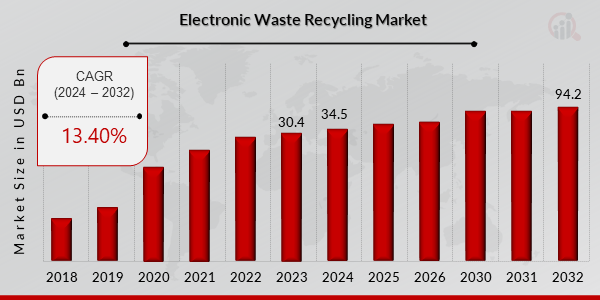
Electronic Waste Recycling Market is Projected to Grow Expeditiously: to Reach USD 94.2 Billion by 2032

Electronic Waste Recycling Market Size
Electronic Waste Recycling Market Research Report Information By Material and Source -Industry Forecast till 2032
CA, UNITED STATES, February 16, 2025 /EINPresswire.com/ -- The Electronic Waste (E-Waste) Recycling Market is witnessing rapid growth, driven by increasing environmental awareness and the rising volumes of discarded electronic devices worldwide. In 2023, the market was valued at USD 30.4 billion and is projected to grow from USD 34.5 billion in 2024 to USD 94.2 billion by 2032, exhibiting a compound annual growth rate (CAGR) of 13.40% during the forecast period (2024–2032).
Key Companies in the Electronic Waste Recycling market include
• Umicore SA (Belgium)
• Quantum Lifecycle Partners (Geep Inc.) (Canada)
• Enviro-Hub Holdings Ltd (Singapore)
• Stena Technoworld AB (Sweden)
• Tetronics International Limited (UK)
• Electronics Recyclers International Inc. (US)
• Sims Limited (US), Aurubis AG (Germany)
• Boliden AB (Sweden)
• Attero Recycling Pvt. Ltd (India)
• Great Lakes Electronics Corporation (US)
• E-Parisaraa Private Limited (India)
• Greentec (Canada)
• Cleanaway (Australia)
• Veolia Environment SA (France).
• Others
Download Sample Pages
https://www.marketresearchfuture.com/sample_request/2553
Key Drivers of Market Growth
1. Growing Electronic Waste Generation
• The increasing consumption of electronic devices, including smartphones, laptops, and home appliances, has led to a surge in e-waste generation.
• Consumers are upgrading their devices more frequently, which further contributes to the growing volume of electronic waste.
2. Stringent Regulations and Environmental Awareness
• Governments and regulatory bodies across the globe are implementing stricter regulations for proper disposal and recycling of e-waste, compelling industries to adopt sustainable practices.
• Extended Producer Responsibility (EPR) laws are pushing manufacturers to take responsibility for the recycling and disposal of their products at the end of their lifecycle.
3. Valuable Materials in E-Waste
• E-waste contains a significant amount of precious metals like gold, silver, and palladium, as well as valuable materials such as copper and rare earth elements, making recycling a lucrative business.
• Recycling these materials reduces the need for mining and helps conserve natural resources, making it an attractive option for businesses and governments.
4. Rising Awareness about the Environmental Impact
• E-waste contains toxic substances such as lead, mercury, and cadmium that can harm the environment and human health if not disposed of properly. This has increased awareness about the importance of responsible e-waste recycling.
• Companies and consumers are increasingly adopting eco-friendly disposal and recycling methods to minimize environmental harm.
Browse In-depth Market Research Report:
https://www.marketresearchfuture.com/reports/electronic-waste-recycling-market-2553
Market Segmentation
1. By Type of E-Waste
• Large Household Appliances – Includes devices like refrigerators, washing machines, and air conditioners.
• Small Household Appliances – Includes gadgets like microwaves, vacuum cleaners, and toasters.
• IT and Telecommunications Equipment – Includes computers, smartphones, tablets, and networking equipment.
• Consumer Electronics – Includes televisions, audio equipment, cameras, and other entertainment devices.
2. By Recycling Process
• Demanufacturing – The disassembly of electronic devices to recover valuable parts, such as metals and plastics.
• Material Recovery – The extraction of precious metals and rare earth elements from e-waste for reuse in manufacturing.
• Refurbishing and Reuse – Restoring old electronic devices for resale or reusing their components in new products.
• Composting and Waste Treatment – The processing of non-recyclable parts of e-waste, such as plastic and glass, to minimize waste.
3. By End-Use Industry
• Consumer Electronics – Recycling of outdated or broken consumer electronic products for component reuse or disposal.
• Automotive – Recyclable parts from automotive electronics, such as sensors, batteries, and wiring.
• Telecommunications – Recycling of obsolete telecommunications equipment and infrastructure.
• Healthcare – E-waste recycling of medical devices and equipment, which often contain valuable materials.
4. By Region
• North America – Leading the market due to stringent e-waste regulations and advanced recycling technologies.
• Europe – Driven by environmental sustainability initiatives and the adoption of EPR policies.
• Asia-Pacific – The fastest-growing region, primarily due to high electronic device consumption and rapid urbanization in countries like China and India.
• Rest of the World (RoW) – Emerging adoption of e-waste recycling practices in Latin America, the Middle East, and Africa.
Procure Complete Research Report Now:
https://www.marketresearchfuture.com/checkout?currency=one_user-USD&report_id=2553
Future Outlook
The Electronic Waste Recycling Market is set for continued expansion, supported by growing electronic waste volumes, stringent regulations, and increasing consumer awareness about environmental issues. As e-waste becomes a valuable source of raw materials and sustainability concerns continue to rise, the demand for efficient recycling processes and technologies will surge.
In addition to material recovery, there will be a growing focus on innovative recycling technologies such as AI-powered sorting and robotics to streamline the e-waste recycling process. The market is expected to see significant advancements in recycling infrastructure, enabling businesses to handle e-waste more efficiently.
Related Report:
Radio-Frequency Identification (RFID) Market
Emotion Detection And Recognition Market
About Market Research Future:
At Market Research Future (MRFR), we enable our customers to unravel the complexity of various industries through our Cooked Research Report (CRR), Half-Cooked Research Reports (HCRR), Raw Research Reports (3R), Continuous-Feed Research (CFR), and Market Research Consulting Services. The MRFR team have a supreme objective to provide the optimum quality market research and intelligence services for our clients. Our market research studies by Components, Application, Logistics and market players for global, regional, and country level market segments enable our clients to see more, know more, and do more, which help to answer all their most important questions.
Market Research Future
+1 855-661-4441
email us here
Market Research Future
Visit us on social media:
Facebook
X
LinkedIn
YouTube
Distribution channels: Technology
Legal Disclaimer:
EIN Presswire provides this news content "as is" without warranty of any kind. We do not accept any responsibility or liability for the accuracy, content, images, videos, licenses, completeness, legality, or reliability of the information contained in this article. If you have any complaints or copyright issues related to this article, kindly contact the author above.
Submit your press release